14.7: Proton as a Common Lewis Acid
- Page ID
- 193776
\( \newcommand{\vecs}[1]{\overset { \scriptstyle \rightharpoonup} {\mathbf{#1}} } \)
\( \newcommand{\vecd}[1]{\overset{-\!-\!\rightharpoonup}{\vphantom{a}\smash {#1}}} \)
\( \newcommand{\id}{\mathrm{id}}\) \( \newcommand{\Span}{\mathrm{span}}\)
( \newcommand{\kernel}{\mathrm{null}\,}\) \( \newcommand{\range}{\mathrm{range}\,}\)
\( \newcommand{\RealPart}{\mathrm{Re}}\) \( \newcommand{\ImaginaryPart}{\mathrm{Im}}\)
\( \newcommand{\Argument}{\mathrm{Arg}}\) \( \newcommand{\norm}[1]{\| #1 \|}\)
\( \newcommand{\inner}[2]{\langle #1, #2 \rangle}\)
\( \newcommand{\Span}{\mathrm{span}}\)
\( \newcommand{\id}{\mathrm{id}}\)
\( \newcommand{\Span}{\mathrm{span}}\)
\( \newcommand{\kernel}{\mathrm{null}\,}\)
\( \newcommand{\range}{\mathrm{range}\,}\)
\( \newcommand{\RealPart}{\mathrm{Re}}\)
\( \newcommand{\ImaginaryPart}{\mathrm{Im}}\)
\( \newcommand{\Argument}{\mathrm{Arg}}\)
\( \newcommand{\norm}[1]{\| #1 \|}\)
\( \newcommand{\inner}[2]{\langle #1, #2 \rangle}\)
\( \newcommand{\Span}{\mathrm{span}}\) \( \newcommand{\AA}{\unicode[.8,0]{x212B}}\)
\( \newcommand{\vectorA}[1]{\vec{#1}} % arrow\)
\( \newcommand{\vectorAt}[1]{\vec{\text{#1}}} % arrow\)
\( \newcommand{\vectorB}[1]{\overset { \scriptstyle \rightharpoonup} {\mathbf{#1}} } \)
\( \newcommand{\vectorC}[1]{\textbf{#1}} \)
\( \newcommand{\vectorD}[1]{\overrightarrow{#1}} \)
\( \newcommand{\vectorDt}[1]{\overrightarrow{\text{#1}}} \)
\( \newcommand{\vectE}[1]{\overset{-\!-\!\rightharpoonup}{\vphantom{a}\smash{\mathbf {#1}}}} \)
\( \newcommand{\vecs}[1]{\overset { \scriptstyle \rightharpoonup} {\mathbf{#1}} } \)
\( \newcommand{\vecd}[1]{\overset{-\!-\!\rightharpoonup}{\vphantom{a}\smash {#1}}} \)
\(\newcommand{\avec}{\mathbf a}\) \(\newcommand{\bvec}{\mathbf b}\) \(\newcommand{\cvec}{\mathbf c}\) \(\newcommand{\dvec}{\mathbf d}\) \(\newcommand{\dtil}{\widetilde{\mathbf d}}\) \(\newcommand{\evec}{\mathbf e}\) \(\newcommand{\fvec}{\mathbf f}\) \(\newcommand{\nvec}{\mathbf n}\) \(\newcommand{\pvec}{\mathbf p}\) \(\newcommand{\qvec}{\mathbf q}\) \(\newcommand{\svec}{\mathbf s}\) \(\newcommand{\tvec}{\mathbf t}\) \(\newcommand{\uvec}{\mathbf u}\) \(\newcommand{\vvec}{\mathbf v}\) \(\newcommand{\wvec}{\mathbf w}\) \(\newcommand{\xvec}{\mathbf x}\) \(\newcommand{\yvec}{\mathbf y}\) \(\newcommand{\zvec}{\mathbf z}\) \(\newcommand{\rvec}{\mathbf r}\) \(\newcommand{\mvec}{\mathbf m}\) \(\newcommand{\zerovec}{\mathbf 0}\) \(\newcommand{\onevec}{\mathbf 1}\) \(\newcommand{\real}{\mathbb R}\) \(\newcommand{\twovec}[2]{\left[\begin{array}{r}#1 \\ #2 \end{array}\right]}\) \(\newcommand{\ctwovec}[2]{\left[\begin{array}{c}#1 \\ #2 \end{array}\right]}\) \(\newcommand{\threevec}[3]{\left[\begin{array}{r}#1 \\ #2 \\ #3 \end{array}\right]}\) \(\newcommand{\cthreevec}[3]{\left[\begin{array}{c}#1 \\ #2 \\ #3 \end{array}\right]}\) \(\newcommand{\fourvec}[4]{\left[\begin{array}{r}#1 \\ #2 \\ #3 \\ #4 \end{array}\right]}\) \(\newcommand{\cfourvec}[4]{\left[\begin{array}{c}#1 \\ #2 \\ #3 \\ #4 \end{array}\right]}\) \(\newcommand{\fivevec}[5]{\left[\begin{array}{r}#1 \\ #2 \\ #3 \\ #4 \\ #5 \\ \end{array}\right]}\) \(\newcommand{\cfivevec}[5]{\left[\begin{array}{c}#1 \\ #2 \\ #3 \\ #4 \\ #5 \\ \end{array}\right]}\) \(\newcommand{\mattwo}[4]{\left[\begin{array}{rr}#1 \amp #2 \\ #3 \amp #4 \\ \end{array}\right]}\) \(\newcommand{\laspan}[1]{\text{Span}\{#1\}}\) \(\newcommand{\bcal}{\cal B}\) \(\newcommand{\ccal}{\cal C}\) \(\newcommand{\scal}{\cal S}\) \(\newcommand{\wcal}{\cal W}\) \(\newcommand{\ecal}{\cal E}\) \(\newcommand{\coords}[2]{\left\{#1\right\}_{#2}}\) \(\newcommand{\gray}[1]{\color{gray}{#1}}\) \(\newcommand{\lgray}[1]{\color{lightgray}{#1}}\) \(\newcommand{\rank}{\operatorname{rank}}\) \(\newcommand{\row}{\text{Row}}\) \(\newcommand{\col}{\text{Col}}\) \(\renewcommand{\row}{\text{Row}}\) \(\newcommand{\nul}{\text{Nul}}\) \(\newcommand{\var}{\text{Var}}\) \(\newcommand{\corr}{\text{corr}}\) \(\newcommand{\len}[1]{\left|#1\right|}\) \(\newcommand{\bbar}{\overline{\bvec}}\) \(\newcommand{\bhat}{\widehat{\bvec}}\) \(\newcommand{\bperp}{\bvec^\perp}\) \(\newcommand{\xhat}{\widehat{\xvec}}\) \(\newcommand{\vhat}{\widehat{\vvec}}\) \(\newcommand{\uhat}{\widehat{\uvec}}\) \(\newcommand{\what}{\widehat{\wvec}}\) \(\newcommand{\Sighat}{\widehat{\Sigma}}\) \(\newcommand{\lt}{<}\) \(\newcommand{\gt}{>}\) \(\newcommand{\amp}{&}\) \(\definecolor{fillinmathshade}{gray}{0.9}\)Perhaps the most common example of a Lewis acid or electrophile is also the simplest. It is the hydrogen cation or proton. It is called a proton because, in most hydrogen atoms, the only particle in the nucleus is a proton. If an electron is removed to make a cation, a proton is all that is left.
- H+ is a very common Lewis acid or electrophile.
A proton is electrophilic for a couple of reasons. It has a positive charge, and so it will attract electrons, which are negative. Also, it lacks the electron configuration of its noble gas neighbour, helium. Helium has two electrons. If a Lewis base or nucleophile donates a pair of electrons to a proton, the proton will obtain a Noble gas configuration. That's part of the reason why, in some periodic tables, hydrogen is shown in two places: at the very left, illustrating its potential to lose an electron, like sodium and lithium; and at the right, illustrating its potential to take on helium's configuration.

There is something about hydrogen cations that is not so simple, however. They are actually not so common. Instead, protons are generally always bound to a Lewis base. Hydrogen is almost always covalently (or datively / coordinately) bonded to another atom.
Many of the other elements commonly found in compounds with hydrogen are more electronegative than hydrogen. As a result, hydrogen often has a partial positive charge. Remember, that is one of the reasons that atoms can act as Lewis acids: with a partial positive charge, an atom becomes electrophilic.
Our statement about protons might better be expressed as:
- Hd+ is a very common Lewis acid or electrophile.

If hydrogens are almost always bonded to other atoms, then the Lewis acid-base interactions we have looked at so far are slightly different here. Instead of two compounds coming together and forming a bond, we have one Lewis base replacing another at a proton.
- Protons are transferred from one basic site to another.
- Transfer occurs by donation of a lone pair to the proton.
Exercise \(\PageIndex{1}\)
Use arrows to show water acting as a Lewis base and donating electrons to the proton in the following compounds.
a) HBr b) HONO2 c) CH3(CO)OH
- Answer a
-

- Answer b
-

- Answer c
-

Exercise \(\PageIndex{2}\)
Consider the following reaction:

• Draw an MO mixing diagram for the reaction above, using the following steps:
o Draw the orbital from the base that is likely to donate its electrons.
o Draw the orbital from the acid that is likely to accept electrons.
o Complete the MO mixing diagram of these two orbitals:
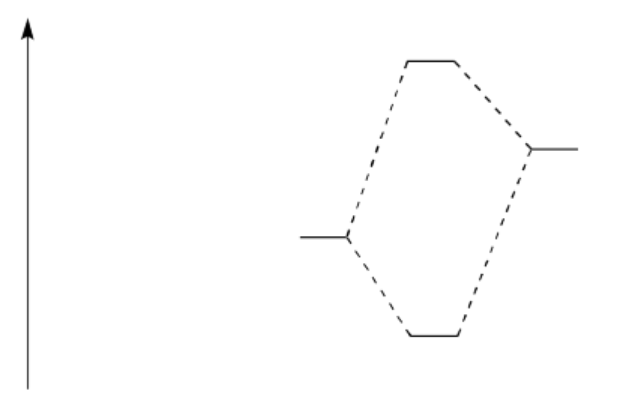
• Label the electron donating orbital
• Label the electron accepting orbital
• Populate the MO mixing diagram with electrons
• Draw a cartoon showing the mixing of these orbitals.
- Answer
-
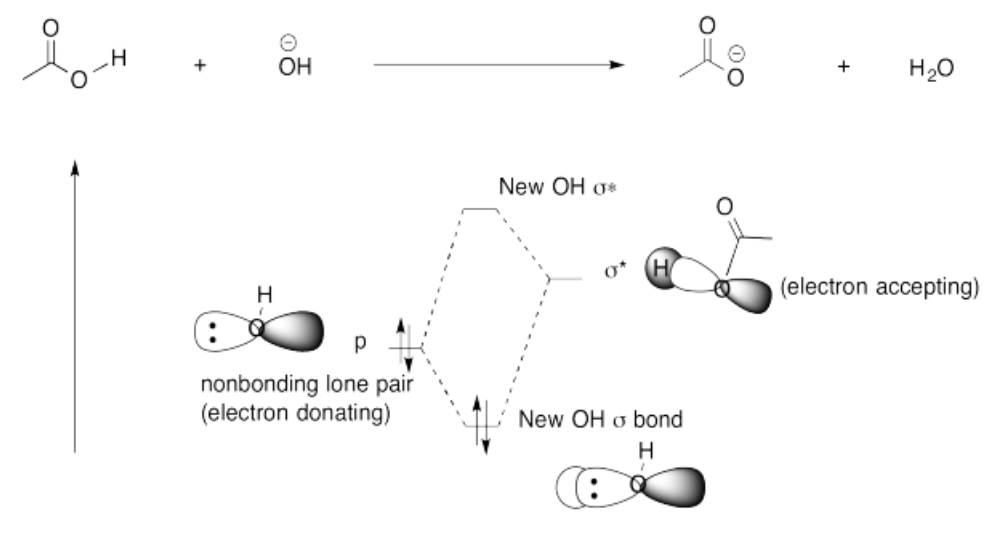
Exercise \(\PageIndex{3}\)
Histidine side-chains contain an imidazole ring, which are unique as they can behave as either a proton-donor or a proton-acceptor depending on surrounding conditions.
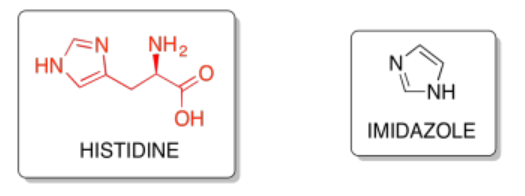
a) Draw in the hydrogen at the chiral center of histidine.
b) Draw the (R)- enantiomer of histidine.
c) Circle the side chain of histidine.
d) Using the energy axis below do the following:
Draw the Hückel MO diagram for imidazole.
Populate the Hückel MO diagram with electrons.
Draw the MO pictures for 3 of the 5 MOs and label each as π, π* or n.
e) Based on your MO diagram, the imidazole is (choose one):
aromatic anti-aromatic non-aromatic
f) Show what imidazole would look like if it gave away a proton.
g) Circle the atom in imidazole that could donate electrons to a proton.
h) Why can't the other nitrogen donate electrons to a proton?
i) Show what imidazole would look like if it did pick up a proton.
Histidine residues frequently hold metal ions in place within enzymes. Enzymes are proteins that catalyze chemical reactions in biological settings. For example, plastocyanins contain a copper(II) ion (Cu2+) which functions to store an electron as it is transported from photosystem II to photosystem I during photosynthesis.
j) The drawing below is a cartoon of an enzyme active site, the place in an enzyme that carries out a specific task. Complete the blank active site by adding thestructures of the missing amino acid side-chains, as indicated by their three-letter codes.
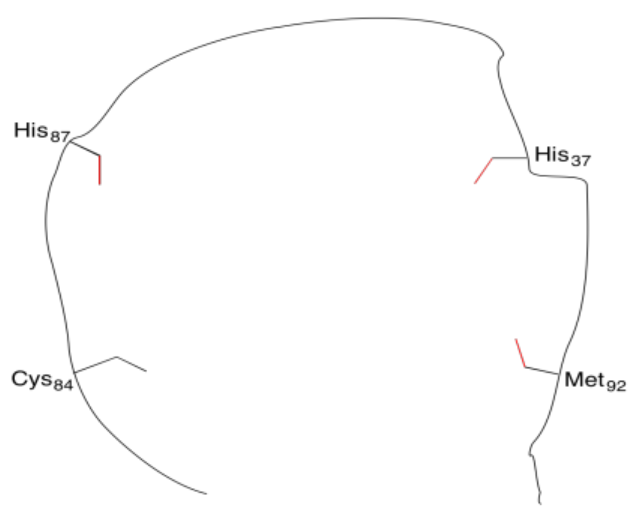
k) Explain why each of these chains is able to bind a Cu2+ ion.
l) Draw a Cu2+ ion in the active site.
m) What is the coordination number for the copper ion in the complex you drew?
n) What is the geometry name for the copper ion in the complex?
o) Let's think about how many valence electrons surround that copper in the complex.
What is the number of valence electrons for copper metal?
What is the number of valence electrons for copper (II) ion?
How many electrons will the donor atoms contribute?
What is total valence electron count for the copper (II) complex?
p) At low pH (when there are lots of protons around), one of the histidines binds a proton. What happens to its ability to bind copper ion?
q) What is the coordination geometry of the copper ion in the complex at low pH?
- Answer e
-
aromatic
- Answer g
-
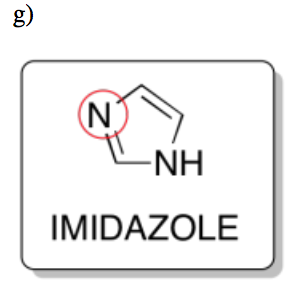
- Answer h
-
This nitrogen atom can donate a lone pair of electrons without disturbing the aromatic character of the molecule.
- Answer k
-
Each side chain has a Lewis base with a lone pair of electrons to donate the copper ion.
- Answer l
-

- Answer m
-
CN = 4
- Answer n
-
tetrahedral
- Answer o
-
Cu: 11 e-
Cu(II): 9 e-
4 x 2e- = 8 e-
8 e- + 9 e- = 17 e-
- Answer p
-
If the imidazole becomes occupied by a proton, then the imidazole no longer has the lone pair to donate to the copper ion.
- Answer q
-
trigonal


